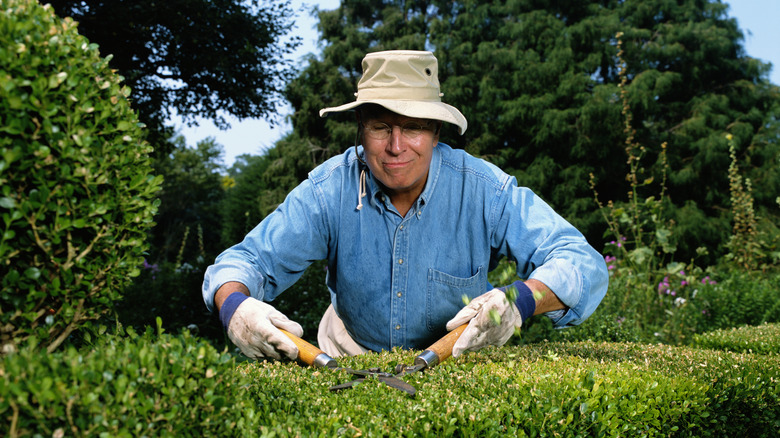Maintenance Tips To Keep Garden Shears In Tip-Top Shape
You've invested in some serious gardening tools, and you want them to last as long as they're designed to. Garden shears, in particular, are worth dropping a bit of cash on — after all, they regularly feature on lists of the most essential gardening tools. Ensuring you get the most out of your pruners requires a little graft on the part of you, the wielder. Like all gardening tools, loppers need regular maintenance to keep them at their best. This means scrubbing them after each use in warm, soapy water, keeping them sharpened and well-oiled, and storing them in a safe, dry location. But probably of chief importance is sterilization, which many garden experts recommend you do with 3% hydrogen peroxide as a go-to option, among other solutions.
The key reason for sterilizing your garden shears is disease prevention. Every time you cut a branch with a sharp-bladed tool — like the shears at the center of this article — or remove some leaves, the open wound creates a site for disease transmission. And hydrogen peroxide is one of the most often recommended garden tool disinfectant chemicals. But does it live up to its reputation? Hydrogen peroxide (3% concentration) did not rate well in a study of garden tool disinfecting substances published in California Agriculture in 1991. But the research was conducted decades ago, and it was specifically focused on stopping the spread of fire blight. Later research on the solution's disinfecting ability, at least where garden tools are concerned, is sparse or contradictory.
Hydrogen peroxide: The star of garden shear sterilization?
Many garden experts assert that hydrogen peroxide can breathe new life into your beloved garden tools. It's the sanitizer of choice when dealing with boxwood blight. "We have hydrogen peroxide bottles in all our greenhouses and staff are trained on sanitizing pruners between plants," says Gemma McNeill, owner-operator of Canada-based Zaklan Farm to Young Agrarians. Other garden authorities state the solution kills any fungi, bacteria, and viruses still clinging to the blades after a wash, though it's most damaging to bacteria.
Place your clean shears, blades facing down, into a waterproof container. Pour enough 3% hydrogen peroxide in — a 32 fluid ounce bottle is about $1 at Walmart — to cover the blades. Leave the tool to soak for up to 15 minutes, then take it out and rinse it in freshwater. You can also spray hydrogen peroxide on the blades and handle. Hydrogen peroxide has no lasting toxic effect once it dries, so do this at least once a week or, ideally, after each use. Alternatively, use hydrogen peroxide spray or soaked cotton balls or wipes — Walgreens sells a pack of 40 for under $6 — to sanitize your pruners between each cut or when moving from plant to plant. Wait five to 10 minutes between cleans to give the chemical time to do its job. Not sold on hydrogen peroxide? There are other expert-recommended sterilizers, including bleach, rubbing alcohol, trisodium phosphate (TSP), pine oil, and specialist products like Physan and Oxidate.
Other essential shears maintenance tips beyond sanitization
Sterilization is just one, though arguably the most important, step in pruner maintenance. Before applying antiseptic, hydrogen peroxide, or otherwise, scrub the tool with a hard-bristled brush and warm, soapy water. After its antiseptic soak, lightly coat all the metal of the shears using WD-40, linseed, tung, coconut, or camellia oil to stop them rusting and keep the moving parts, well, moving. A paper towel or rag works well here; make sure the tool is completely dry before oiling it. Your plants will thank you if you incorporate a deep clean, where you disassemble the tools before scrubbing them, into your seasonal or annual garden maintenance routine.
Shears get blunt with use, so it's a good idea to sharpen them whenever they start to feel dull or struggle to get through a branch. If you feel confident using a whetstone or carbide file (great for small blades), do it yourself. If not, send them away to a professional knife sharpener. Search online or ask at your local farmer's market for similar services near you. Where you store your tools between uses also plays a large part in their maintenance and longevity. Put them away neatly after each use, somewhere cool, dry, and off the ground. Store your garden tools in a sand mixture so they don't rust or hang them on a wall rack.
